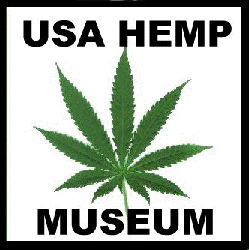
HEMP MEDICAL & HEALTH ROOM
USA Hemp Museum Store - Bookmark This Site - Museum Link - Email The Museum
 |
HEMP MEDICAL & HEALTH ROOM USA Hemp Museum Store - Bookmark This Site - Museum Link - Email The Museum |
|
HEMP MEDICAL & HEALTH ROOM GUIDE A SHORT HISTORY OF MEDICAL HEMP What are the numbers?
|
|
The long association of people with the hemp plant
suggests that medical use of Cannabis began in antiquity. Before
people could write there were medicine people who used the herbs of
nature for healing. Of written records we have 5,000 years
according to Judge Young. The Drug Enforcement Administration's own record (Docket #86-22, p.27) affirms that: "The record on marijuana (Cannabis) encompasses 5,000 years of human
experience." Dewey in the USDA Yearbook, 1913, stated that medical cannabis has been ubiquitous in human history, and its use was advised in virtually all ancient and medieval medicinal texts.
|
 |
|
Writings place hemp drugs in India prior to 800 B.C., although the origin of the term "Indian hemp" has been lost. The use of Cannabis in western medicine was enhanced by a monograph of Dr. William B. O'Shaughnessy, who was a British East India Company surgeon in Calcutta, India. He experimented with it on himself, animals, and patients and recommended gunjah for a great variety of therapeutic purposes. In 1973 Tod Mikuriya, M.D., compiled major medical works on cannabis into the book Marijuana: Medical Papers, 1839-1972. |
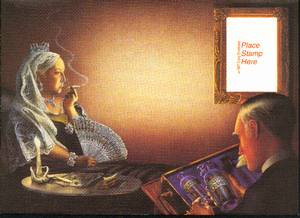 |
Queen Victoria of England, smoking
a medicinal joint recommended by her doctor for menstrual
cramps. Hemp Museum Envelope. |
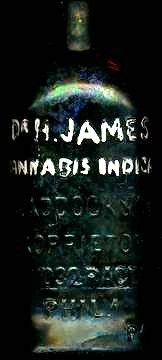 |
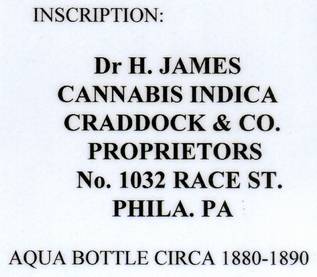
Hemp Museum display of medicine bottle that contained Cannabis Indica Tincture, long before marijuana became its mongrel name. Who said it wasn't medicine? |
 |
HERB JUICE. The original purpose of the U.S. Food and Drug Administration (F.D.A.), was to tell the consumer that what was really listed on the label of herb juice was in the bottle, and nothing else. Its purpose was not to prohibit the sale of herb juice. |
| The Marijuana Tax
Act of 1937 put the control of the plant under the Bureau of Narcotics,
which led to its prohibition for all uses in a few years, including its
prohibition for industrial uses such as paper, fiber, fuel, food, medicine,
etc. The Marijuana Tax Act led in 1961 to marijuana being placed in the United Nations Single Convention on Narcotics Use. This despite the fact that marijuana is not narcotic, not addictive. The Single Convention does allow for medical, and industrial use of Marijuana (Cannabis/hemp). The Marijuana Tax Act of 1937 was declared unconstitutional by the Supreme Court in 1969, in U.S. v. Leary. In 1970, Congress included marijuana in the Controlled Substances Act that is still in force, as a Schedule I most dangerous drug, with no medical value, where it still sits. In 1972, the National Organization for the Reform of Marijuana Laws, NORML, filed suit to reschedule marijuana for medical use, Schedule II. In 1988, sixteen years later, the NORML suit culminated in a ruling by the DEA itself, that marijuana by law should be rescheduled to Schedule II. The head of the DEA at that time Robert Bonner, refused to reschedule in violation of the scheduling laws. |
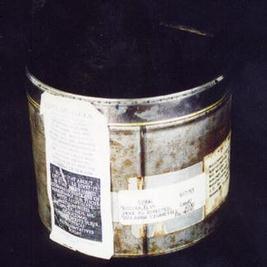 |
Hemp Museum Tin that contained 300 U.S.A. government grown and rolled marijuana cigarettes still issued to 7 Americans as a result of a now defunct Independent New Drug experimental program. The quality was very bad (yes I tried some and inhaled), forcing the patients to smoke over twice the amount to get relief as when they had good bud. With smoking the effect is much faster that eating, and easier to control the dosage. |
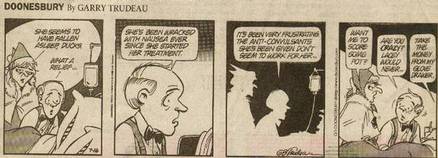 |
Doonesbury, by Garry Trudeau. |
HEMP MEDICAL & HEALTH ROOM GUIDE
USA Hemp Museum Store - Bookmark This Site - Museum Link - Email The Museum